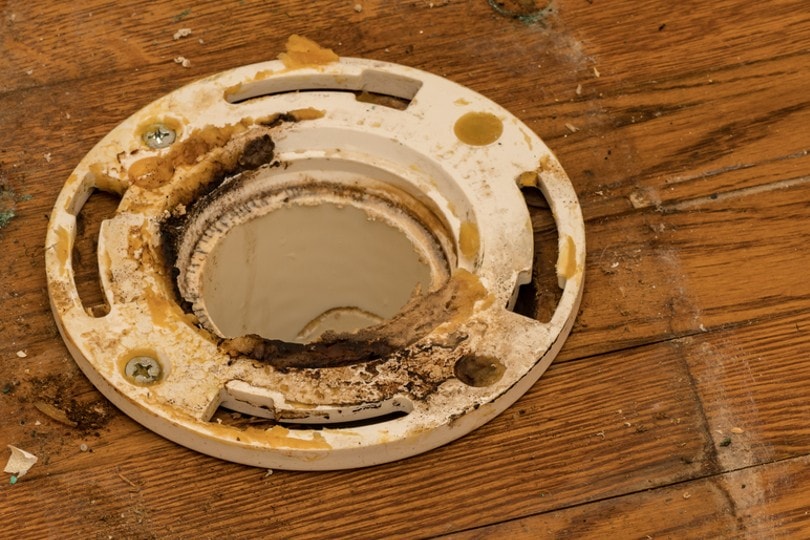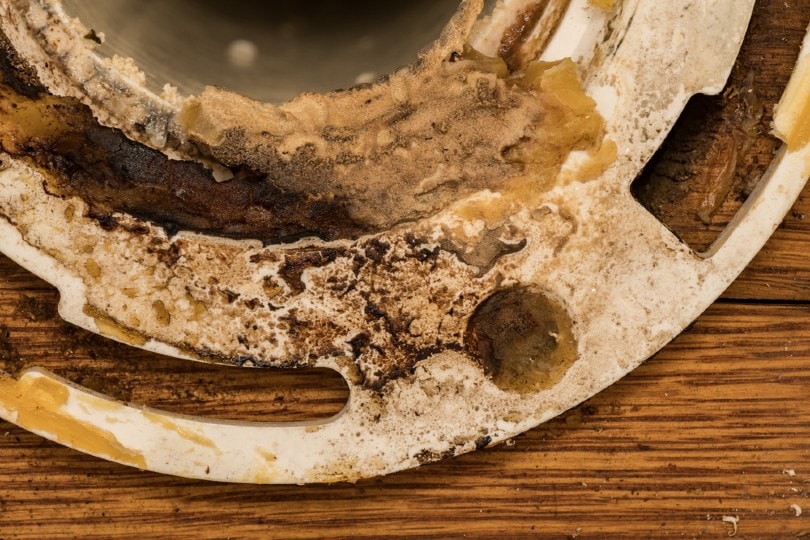What Is a Toilet Flange? Types, Pros, Cons, & FAQ
-
Pete Ortiz
- Last updated:

Toilets are made up of individual parts that work together. One of the most important parts is the toilet flange. The flange is what connects the physical toilet to the drainage system underneath the floor. Furthermore, this part is responsible for securing the toilet in place and preventing any leakage.
If the toilet flange is acting up, it’s important to fix the problem right away. Luckily, the toilet flange is a relatively simple part that is easy to access and fix if needed. If you have the right skills, you should be able to replace the flange on your own, but plumbers can get the job done easily on your behalf.
For a complete look at what the toilet flange is and how it works, keep reading.
How Does It Work?
How a toilet flange works is pretty simple. It is simply a pipe fitting that will connect your toilet to the drainage system and secure it firmly to your finished floor. The toilet flange includes a few parts to create a waterproof seal that is safe and long-lasting.
The flange itself is a circular pipe fitting that can be made from PVC, cast iron, or brass. The material you should select should match the drainage system in your bathroom. So, select a PVC flange if the drainage system is made from PVC but cast iron if the system is cast iron.
Inside the flange, there will be a wax ring. This wax ring is mounted directly on the flange to create a water-tight seal between the toilet and the flange itself. This ring also helps to keep odors and gases from escaping.
The flange and wax ring will be mounted to the ground using rust-proof screws. You simply screw the piece into place and then set your toilet over top.

What Are the Different Types of Toilet Flanges?
All toilet flanges have the same purpose and design. However, there are different types of toilet flanges. Most toilet flanges are determined by the type of material that is used within the connection and pipe. Here’s a look at the most common types:
PVC Flange
The PVC flange is one of the most affordable and common. It is designed to match connection systems that are made from PVC or ABS.
Cast Iron Flange
Cast iron is another popular material flanges are made from. These flanges are selected whenever the connecting system is made from cast iron.
Brass Flange
You probably get what brass flange is and when it is used. Just in case, this flange is made from brass and matches connection systems made from brass.
Specialty Flanges
Occasionally, you may need a specialty flange depending on where your toilet is located or its features. Some examples of specialty flanges include offset closet flanges and 45-degree closet flanges. Even though these are known as specialty options, specialty options aren’t super rare today.
Where Is It Used?
Toilet flanges are used in the bathroom. Whenever there is a toilet, there should be a toilet flange as well. After all, the flange is what secures a tight connection and prevents the toilet from leaking or allowing odors to escape.
You will not be able to see the flange without removing the toilet. However, it is located right underneath the base of the toilet. If you were to lift up the toilet, the toilet flange is what would be located in that empty spot.
Advantages of a Toilet Flange
The toilet flange is a necessary part of any toilet. On the one hand, it creates a clean finish between the toilet and the connection system. Thanks to the flange, your toilet will be properly secured to the ground, and you won’t have to worry about movements or wiggles.
Furthermore, the wax ring inside the toilet flange helps to keep your bathroom clean and free of leaks, mold, or odors. This wax ring ensures that the slightest leaks and odors do not sneak out where the toilet meets the drainage system.
Consequently, it helps to save you money, too. Since you don’t have to worry about leaks or odor escaping, you also don’t have to worry about gas leaks or water damage that you have to pay to fix.
Disadvantages of a Toilet Flange
Whenever a toilet flange works as it should, there are very few disadvantages. However, toilet flanges have an expiration date just like anything else in your home. Once the toilet flange breaks, you might start experiencing leaks and odors. In that case, you will have to replace the toilet flange.
Replacing the toilet flange can be a bit of a hassle, though it is relatively easy if you know what you’re doing. You have to remove the toilet. If you do not know what you’re doing, it’s best to hire a professional, and you will end up paying for a new toilet flange and labor costs associated with installation.
Another downside is that the toilet flange you select must match the drainage system in your home. If you select a PVC flange but have a cast iron system, the items will not work as they should, and the flange will likely break. So, it’s important to know the material your drainage system is made from before you select the flange.
Not to mention, the drainage system may be in an odd location. In that case, you will have to buy a specialty toilet flange that still matches the material of the system. These specialty flanges may cost a little bit more money, but they are worth the money since they keep your home clean and safe.
Individual toilet flanges can have downsides as well. For example, a PVC flange is easier to break than a cast iron or brass flange, but the metal flanges are more expensive. Unfortunately, there’s little you can do to avoid these downsides since you have to select the material based on the material of the drainage system.
Frequently Asked Questions (FAQ)
What does a flange do on a toilet?
The flange connects the toilet to the drainage system underneath your floor. It creates a water-tight seal, so odors and water go straight into the drainage system. It also securely mounts your toilet to your finished floor.
When should I replace a toilet flange?
It’s time to replace your toilet flange if you notice any leaks or odors coming from the bottom of your toilet. You should also replace the toilet flange if it appears broken or cracked.
How much does it cost to replace a toilet flange?
Replacing a toilet flange is relatively affordable. Most plumbers can replace a flange for $145–$200, including the price of the flange itself. If you want to replace the flange on your own, you only have to pay for the part, which costs about $20–$50.
However, keep in mind that you’ll end up paying hundreds or thousands of dollars if you end up damaging the piping or toilet while trying to replace the flange. So, contact a professional if you are not confident in your ability to replace the flange on your own.
Do all toilets need a flange?
Yes, all toilets should have a flange. Without a flange, your toilet will not securely sit on the floor and will likely experience leaks and odors.
Final Thoughts
A toilet flange is the fitting that connects the drainage system directly to the bottom of your toilet. Because of the wax ring within the flange, the flange also protects from leaks and odor slippage.
Although you might feel that the flange is an unnecessary part of the toilet, it is necessary for a secure, safe, and hygienic toilet. If you suspect there’s something wrong with your flange, it’s important to replace it ASAP.
Featured Image Credit: CLS Digital Arts, Shutterstock
Contents



